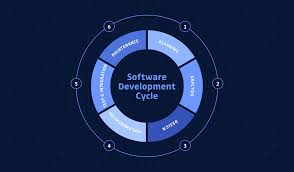Web App Programming: A Comprehensive Guide
In today’s digital age, web applications have become an integral part of our daily lives. From social media platforms to online shopping websites, web apps are everywhere. But have you ever wondered how these web apps are created and programmed? In this article, we will delve into the world of web app programming and explore the key concepts and technologies involved.
At the core of web app programming is a combination of front-end and back-end development. Front-end development focuses on the user interface and user experience of the web app. This involves using technologies such as HTML, CSS, and JavaScript to create interactive and visually appealing interfaces that users can interact with.
HTML (Hypertext Markup Language) is used to structure the content of a web page, defining headings, paragraphs, images, links, and other elements. CSS (Cascading Style Sheets) is then used to style the HTML elements, controlling aspects such as layout, color, font size, and spacing. JavaScript adds interactivity to the web app by enabling dynamic content updates, form validation, animations, and much more.
On the other hand, back-end development focuses on the server-side logic that powers the web app. This involves using programming languages such as Python, Ruby, PHP, or Node.js to handle data processing, database interactions, user authentication, and other server-side functionalities.
Web developers often use frameworks and libraries to streamline the development process and enhance productivity. Popular front-end frameworks like React.js or AngularJS provide reusable components and efficient state management for building complex user interfaces. For back-end development, frameworks like Django (Python), Ruby on Rails (Ruby), Laravel (PHP), or Express.js (Node.js) offer tools for routing requests, handling databases, and managing server-side operations.
In addition to front-end and back-end development, web developers also need to consider aspects like security, performance optimization, cross-browser compatibility testing, responsive design for mobile devices, and accessibility standards to ensure a seamless user experience across different platforms.
In conclusion,
web app programming is a multifaceted discipline that requires a solid understanding of both front-end and back-end technologies. By mastering key concepts like HTML,
CSS,
JavaScript,
and utilizing frameworks/libraries for efficient development,
web developers can create powerful
and engaging applications that cater to modern digital needs.
Whether you’re a beginner looking to learn the basics or an experienced developer seeking advanced techniques,
web app programming offers endless possibilities for innovation
and creativity in today’s fast-paced digital landscape.
9 Essential Tips for Effective Web App Programming
- Follow best practices for security to protect against common vulnerabilities like SQL injection and cross-site scripting (XSS).
- Optimize your code and assets for performance to ensure fast loading times and smooth user experience.
- Use version control systems like Git to manage your codebase effectively and collaborate with other developers.
- Implement responsive design to ensure your web app looks good and functions well on various devices and screen sizes.
- Write clean, readable code with meaningful variable names, comments, and proper indentation for easier maintenance and debugging.
- Regularly test your web app for bugs and issues using automated testing tools as well as manual testing by real users.
- Consider accessibility standards to make your web app usable for people with disabilities, including screen readers compatibility.
- Document your codebase thoroughly with clear explanations of functionality, APIs, dependencies, and any setup instructions for new developers.
- Stay updated with the latest trends in web development technologies and frameworks to enhance your skills and build better web apps.
Follow best practices for security to protect against common vulnerabilities like SQL injection and cross-site scripting (XSS).
When it comes to web app programming, following best practices for security is paramount to safeguard against common vulnerabilities such as SQL injection and cross-site scripting (XSS). By implementing proper security measures, such as input validation, parameterized queries, and escaping user inputs, developers can mitigate the risk of malicious attacks that exploit these vulnerabilities. Prioritizing security in the development process helps ensure the integrity and confidentiality of data within the web application, providing a safe and secure user experience.
Optimize your code and assets for performance to ensure fast loading times and smooth user experience.
Optimizing your code and assets for performance is crucial in web app programming to guarantee fast loading times and a seamless user experience. By minimizing unnecessary code, optimizing images and other assets, and implementing efficient algorithms, you can significantly improve the speed and responsiveness of your web app. This not only enhances user satisfaction but also boosts search engine rankings and overall performance metrics. Prioritizing performance optimization in your web development process is key to delivering a high-quality product that meets the expectations of modern users.
Use version control systems like Git to manage your codebase effectively and collaborate with other developers.
In web app programming, it is essential to use version control systems like Git to manage your codebase effectively and collaborate with other developers. By utilizing Git, developers can track changes made to the code, revert to previous versions if needed, and work on different features concurrently without conflicts. This not only ensures a more organized and efficient development process but also promotes seamless collaboration among team members by providing a centralized platform for sharing and merging code changes. Incorporating version control systems like Git into your workflow is crucial for maintaining code integrity, improving productivity, and facilitating teamwork in web app development projects.
Implement responsive design to ensure your web app looks good and functions well on various devices and screen sizes.
Implementing responsive design is a crucial tip in web app programming to ensure that your application looks visually appealing and functions seamlessly across a wide range of devices and screen sizes. By utilizing responsive design techniques such as fluid grids, flexible images, and media queries, you can create a user-friendly experience that adapts to different viewport sizes, from desktop computers to smartphones and tablets. This approach not only enhances the accessibility and usability of your web app but also improves its overall performance and user engagement.
Write clean, readable code with meaningful variable names, comments, and proper indentation for easier maintenance and debugging.
When it comes to web app programming, a crucial tip is to prioritize writing clean, readable code. By using meaningful variable names, adding comments to explain complex logic, and ensuring proper indentation, developers can greatly enhance the maintainability and debugging process of their code. Clear and well-organized code not only makes it easier for other team members to understand and collaborate on the project but also simplifies troubleshooting and identifying errors in the codebase. Investing time in writing clean code upfront can save hours of frustration down the line during maintenance and debugging tasks.
Regularly test your web app for bugs and issues using automated testing tools as well as manual testing by real users.
Regularly testing your web app for bugs and issues is crucial to maintaining its functionality and user experience. By utilizing automated testing tools, you can efficiently identify and address potential issues in your codebase, ensuring a smoother user experience. Additionally, manual testing by real users provides valuable feedback on usability, performance, and overall satisfaction with the web app. Combining both automated testing tools and manual testing by real users allows you to catch a wide range of issues and continuously improve your web app for optimal performance and user satisfaction.
Consider accessibility standards to make your web app usable for people with disabilities, including screen readers compatibility.
When developing a web app, it is crucial to consider accessibility standards to ensure that your application is usable for all users, including those with disabilities. One important aspect to focus on is screen reader compatibility, as visually impaired users rely on screen readers to navigate and interact with web content. By following accessibility guidelines and making your web app compatible with screen readers, you can provide an inclusive and user-friendly experience for all individuals, regardless of their abilities. Prioritizing accessibility not only enhances the usability of your web app but also demonstrates a commitment to creating an inclusive digital environment for everyone.
Document your codebase thoroughly with clear explanations of functionality, APIs, dependencies, and any setup instructions for new developers.
One crucial tip in web app programming is to meticulously document your codebase with detailed explanations of functionality, APIs, dependencies, and setup instructions for new developers. Clear documentation serves as a roadmap for understanding the intricacies of the codebase, enabling seamless collaboration and onboarding of new team members. By providing comprehensive documentation, developers can easily grasp the purpose and structure of the code, troubleshoot issues efficiently, and accelerate the development process. Investing time in thorough documentation not only enhances code maintainability but also fosters a cohesive and productive development environment.
Stay updated with the latest trends in web development technologies and frameworks to enhance your skills and build better web apps.
To excel in web app programming, it is crucial to stay updated with the latest trends in web development technologies and frameworks. By keeping abreast of industry advancements, developers can enhance their skills and create better web apps that meet the evolving needs of users. Embracing new technologies and frameworks not only improves efficiency but also opens up opportunities for innovation and creativity in web development. Continuous learning and adaptation to new trends are key to staying competitive in the dynamic field of web app programming.



